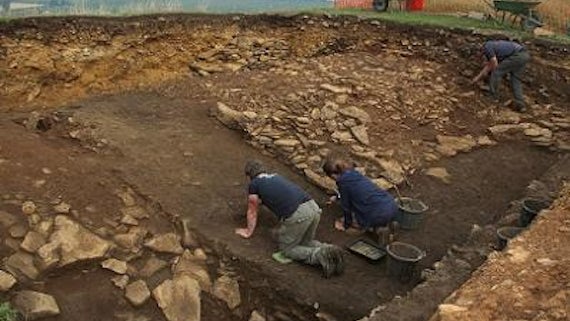2,500 year-old human remains discovered
2 Medi 2013

Human remains more than 2,500 years old have been discovered by archaeologists from Cardiff and Cambridge universities during their final season of excavations at the UK's largest Iron Age hillfort.
Over the last three summers, Niall Sharples of Cardiff's School of History, Archaeology and Religion and Christopher Evans of the Cambridge Archaeological Unit have led a team excavating an extensive area of Ham Hill in Somerset.
Trial excavations at the start of the project revealed one Iron Age skeleton and this year's dig has revealed further remains.
"Ham Hill overlooks the county's marshland levels, and in thoroughly green and pleasant lands, its picturesque setting certainly jars against the number of human remains that are being found," said Christopher Evans.
"Our work this year is concentrated on an area of the hillfort constructed at the end of the Iron Age to (unsuccessfully) defend the hillfort against the oncoming Romans. It consists of an imposing box-revetted stone rampart set on top of earlier earthen banks. Human remains in the deposits behind it, evinces a violent assault and these remains appear to have been de-fleshed or chopped up and left exposed on the surface. Roman military items have also been discovered and the hill-top may well have been garrisoned in the initial period of the Roman occupation of the South West," added Christopher.
Hillforts are one of the most common and widespread monuments of British prehistory, and the team has been given special permission to excavate Ham Hill. Their work has provided an understanding of the hillfort's enormous ramparts and given an insight into Iron Age life at the site.
Niall Sharples said: "The excavated enclosure does not seem to have been occupied but was a largely empty and short-lived space, appearing to have been deliberately destroyed, perhaps after only 5-10 years.
"It could have been a meeting place, maybe for the community to gather to make decisions. Another reason for thinking that this was a special place is the quantity of human remains. Several burials have been discovered, in pits and within the enclosure ditch. Fragments of human skull and other isolated bones have also been recovered that appear to have been scattered across the area, possibly circulated as tangible representations of ancestors. Perhaps these ancestors were called upon when important decisions had to be made?."
Members of the public can find out more about the excavation and its discoveries at a site open-day on the 7th of September 2013.